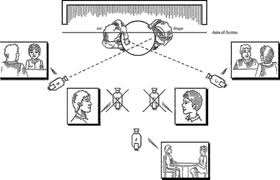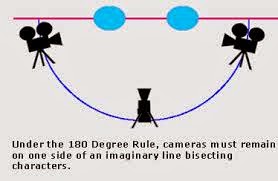Becky
- Storyboard Artist
- Prop Manager
- Actress
- Editing(sound effects and annimatic)
Beth
- Camera Operator
- Casting Director
- Editing(film and annimatic)
Megan
- Director
- Location Scout
- Actress
- Editing(title sequence)
Our positions have been designated due to our own personal skills, to ensure our film is of as high quality as possible. By including our own personal skills to our film allows for individuality which can be seen in our editing and acting skills.
Tuesday, 17 December 2013
Match on Action
Match on action is a very simple but essential technique, where the perspective of the camera changes during a scene and the scene continues to flow. It is used to create a sense of continuity as one shot is cut to another shot portraying the action of the subject in the first shot. The action carrying through creates a 'visual bridge' which takes the viewers attention away from the cutting making it seem continuous.

This is an example of match on action from 'Friends.' The camera shows a medium shot of Chandler closing the door, with his body slightly turned towards the audience. The camera then cuts to a long shot where he can be seen standing in exactly the same position with his hand still on the door knob. The match on actions causes the transaction between shots to appear smoother, and evidently less noticeable. The same can be seen again in a medium shot of Monica placing her hands on Chandler shoulders and leaning in for a kiss. The shot then becomes a medium long shot, where her hands can be seen in exactly the same position as she continues to lean in. As a result, the cut appears to be more fluid.
This match on action clip from the 1938 black and white film, 'Bringing Up Baby' successfully shows how match on action is used to create a sense of flow in a scene when Susan strikes a match in one frame and in the next, she lifts it towards her lips to light her cigarette.
Beth
Shot/ Reverse Shot

A 'Shot/Reverse shot' is often used in conversation the capture the facial expressions of both characters. As seen in the above diagram, three cameras are usually used. Camera B is an over the shoulder show of a male character, with the female character situated within focus, while camera C is the same shot but in reverse, with it being the male character in focus. Camera A is an overview of both characters within the scene.
During a conversation, shots will switch between Camera's B and C, depending on which character is speaking and which is reacting. The B,C and back to B sequence of the camera's is the Shot/Reverse Shot.
This short clip from The Hunger Games (2012) shows how the use of shot/reverse shot helps the narrative to flow and show characters facial expressions clearly for a spectator.
Beth and Becky
Thursday, 12 December 2013
The 180 Degree Rule
The 180 degree rule is used to create the sense of continuity, it makes the audience less inclined notice the small cuts that are used when filming. If the camera is moved then the cut will become obvious and the character will be facing the opposite direction.
The 180 degree rule states that the camera(s) should remain the same side of the 'imaginary line.' The line is situated between both characters within the shot, perpendicular to the camera's viewpoint.
 Breaking the rule could result in audience confusion, as the position of the main character within the shot is always changing. The audience may begin to lose focus as a result of the disorientation and miss vital parts of the film. Crossing the line while filming shifts the actors eye lines, meaning that they do not match.
Breaking the rule could result in audience confusion, as the position of the main character within the shot is always changing. The audience may begin to lose focus as a result of the disorientation and miss vital parts of the film. Crossing the line while filming shifts the actors eye lines, meaning that they do not match.
The only way to cross the line without causing audience confusion is to show the camera movement, for example through a pan around the characters. However, once the movement has been shown and the line has been crossed, the only way to cross back over would be to again show the movement, so it is often advised to stay on that side of the line for the rest of the scene.
An example of this is if a character is walking towards the left in one shot, but when the shot is changed to the other side of the 180 degree line the character is then walking to the right of the screen. This means that it is then unclear to the audience where the character is actually going.
This clip shows the 180 degree rule in easy steps and how putting the camera on the other side of the line will stop the focus of eye-line match.
The 180 degree rule states that the camera(s) should remain the same side of the 'imaginary line.' The line is situated between both characters within the shot, perpendicular to the camera's viewpoint.
 Breaking the rule could result in audience confusion, as the position of the main character within the shot is always changing. The audience may begin to lose focus as a result of the disorientation and miss vital parts of the film. Crossing the line while filming shifts the actors eye lines, meaning that they do not match.
Breaking the rule could result in audience confusion, as the position of the main character within the shot is always changing. The audience may begin to lose focus as a result of the disorientation and miss vital parts of the film. Crossing the line while filming shifts the actors eye lines, meaning that they do not match.The only way to cross the line without causing audience confusion is to show the camera movement, for example through a pan around the characters. However, once the movement has been shown and the line has been crossed, the only way to cross back over would be to again show the movement, so it is often advised to stay on that side of the line for the rest of the scene.
An example of this is if a character is walking towards the left in one shot, but when the shot is changed to the other side of the 180 degree line the character is then walking to the right of the screen. This means that it is then unclear to the audience where the character is actually going.
This clip shows the 180 degree rule in easy steps and how putting the camera on the other side of the line will stop the focus of eye-line match.
Our Task
Our preliminary task is to 'create a continuity task involving filming and editing a character opening a door, crossing a room and sitting down in a chair opposite another character which whom she/he then exchanges a couple of lines of dialogue.'
Our sequence will last no longer than one minute, and will demonstrate 'match on action,' 'shot/reverse shot' and the '180 degree rule.' Music, dialogue and sound effects with also be incorporated within out film, and all filming will take place on campus using college equipment. We will then record all of our progress onto our group blog, which along with the practical task will be completed by Friday the 17th of January 2014.
Beth
Our sequence will last no longer than one minute, and will demonstrate 'match on action,' 'shot/reverse shot' and the '180 degree rule.' Music, dialogue and sound effects with also be incorporated within out film, and all filming will take place on campus using college equipment. We will then record all of our progress onto our group blog, which along with the practical task will be completed by Friday the 17th of January 2014.
Beth
Subscribe to:
Comments (Atom)
